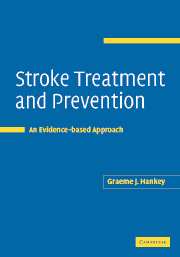Book contents
- Frontmatter
- Contents
- Preface
- 1 The size of the problem of stroke
- 2 Understanding evidence
- 3 Organised acute stroke care
- 4 General supportive acute stroke care
- 5 Reperfusion of ischaemic brain by thrombolysis
- 6 Augmentation of cerebral blood flow: fibrinogen-depleting agents, haemodilution and pentoxifylline
- 7 Neuroprotection
- 8 Treatment of brain oedema
- 9 Anticoagulation
- 10 Antiplatelet therapy
- 11 Carotid artery revascularisation
- 12 Lowering blood pressure
- 13 Lowering blood cholesterol concentrations
- 14 Modification of other vascular risk factors and lifestyle
- 15 Antithrombotic therapy for preventing recurrent cardiogenic embolism
- 16 Arterial dissection and arteritis
- 17 Treatment of intracerebral haemorrhage
- 18 Treatment of subarachnoid haemorrhage
- References
- Index
2 - Understanding evidence
Published online by Cambridge University Press: 23 December 2009
- Frontmatter
- Contents
- Preface
- 1 The size of the problem of stroke
- 2 Understanding evidence
- 3 Organised acute stroke care
- 4 General supportive acute stroke care
- 5 Reperfusion of ischaemic brain by thrombolysis
- 6 Augmentation of cerebral blood flow: fibrinogen-depleting agents, haemodilution and pentoxifylline
- 7 Neuroprotection
- 8 Treatment of brain oedema
- 9 Anticoagulation
- 10 Antiplatelet therapy
- 11 Carotid artery revascularisation
- 12 Lowering blood pressure
- 13 Lowering blood cholesterol concentrations
- 14 Modification of other vascular risk factors and lifestyle
- 15 Antithrombotic therapy for preventing recurrent cardiogenic embolism
- 16 Arterial dissection and arteritis
- 17 Treatment of intracerebral haemorrhage
- 18 Treatment of subarachnoid haemorrhage
- References
- Index
Summary
One of the challenges in finding effective treatments for stroke is that stroke is not a single entity. Stroke has a broad spectrum of clinical features, pathologies, aetiologies and prognoses. Consequently, there is wide variation in the types of treatments for stroke and in the response of patients to effective treatments. This means that there is a low likelihood that there will ever be a single ‘magic bullet’ to treat all types of stroke. A similar analogy can be seen with infectious diseases and cancers. They also have a broad spectrum of clinical features, pathologies, causes and outcomes. As a result, there are a range of antibiotic and antineoplastic treatments targeting different aetiologies and mechanisms of cellular injury and, even in targeted patients, their effectiveness is variable. This is because the response of patients is also determined by other genetic and acquired factors.
Given that there are likely to be different treatments for different causes and sequelae of stroke, and different responses in different patients, stroke researchers need to ideally aim to evaluate the effects of treatments for particular pathological and aetiological subtypes and sequelae of stroke, and stroke clinicians need to ideally strive to target effective treatments to appropriate patients who are likely to respond favourably.
Stroke clinicians therefore need to know which treatments for patients with particular types and sequelae of stroke are effective (and ineffective), and their respective risks and costs. Theory alone is insufficient for guiding practice; treatments should have been tested appropriately and thoroughly in clinical practice (Doust and Del Mar, 2004).
- Type
- Chapter
- Information
- Stroke Treatment and PreventionAn Evidence-based Approach, pp. 9 - 30Publisher: Cambridge University PressPrint publication year: 2005



